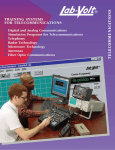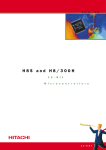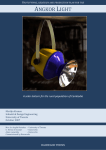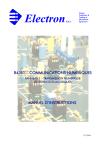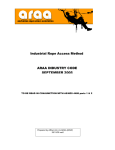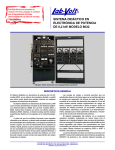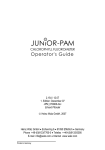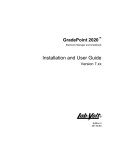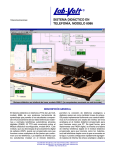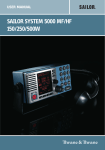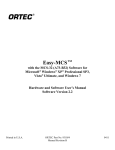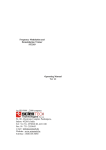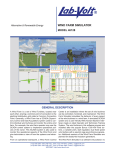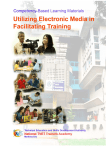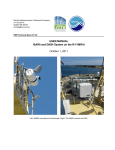Download - Eurociencia.com
Transcript
A TL U FA SS I N E ST D CI R N IO O CU & S IT PR I S O F OR SS E C N RO T EC EL NG TRAINING SYSTEMS F O R T E L E C O M M U N I C AT I O N S • • • • • • • OL R NT O C Y OG L M NO NO U H H R C G EC ST TE IN T N T I A OR RY S HE O S T & CE RA G O O N PR PL NI O X O R I E IT IC D M & ON L C A R IT AI G I , D ON I T RA S E IG ON I R T F CA RE I UN M OM C LE TE S IC ER N W RO PO T C D LE UI L E S F & OL Y R T NT CI I O C TR C & E R E EL W O P C I R CT E EL T TA N E GY O L World Leader in Technical Training Systems TA94001-00- Rev. E Digital and Analog Communications Simulation Programs for Telecommunications Telephony Radar Technology Microwave Technology Antennas Fiber Optic Communications TELECOMMUNICATIONS T AU OM IO AT & B RO C TI CS I IN A TR ) ET C A (F z Electric Power and Control z - Electromechanical - Power Electronics and Drives - Power Transmission, Distribution, and Protection - Industrial Controls z z - Telecommunications - Digital and Analog Telecommunications Radar Technology Microwave Technology Antenna Telephony Fiber Optic Communications Manufacturing/Mechatronics - Tech-Design® Automation and Robotics Fluid Power Instrumentation and Process Control Refrigeration, Air Conditioning, and Heating - Exploratory Technology z Communications Transportation Construction Manufacturing Bio-Related Family & Consumer Sciences Tech-World® - Applications in Manufacturing - Applications in Information Technology z Computer-Based Electronics Training System (FACET®) - Basic Principles of Electricity and Electronics - Circuit Simulations - Digital and Microprocessor Electronics - Telecommunications - Industrial Electronics CENTRAL SALES & MANUFACTURING OFFICES LAB-VOLT SYSTEMS, INC. Farmingdale, New Jersey, USA 07727 Telephone (732) 938-2000 Fax (732) 774-8573 Toll Free U.S. Telephone (800) LAB-VOLT E-MAIL: [email protected] LAB-VOLT LIMITED Charlesbourg, Québec, CANADA G2N 2K7 Telephone (418) 849-1000 Fax (418) 849-1666 Toll Free Canada Telephone (800) LAB-VOLT E-MAIL: [email protected] LAB-VOLT’S WEB SITE www.labvolt.com ©Copyright 2005, Lab-Volt Systems, Inc. All rights reserved. All products featured in this guide are subject to change without notice. Lab-Volt recognizes all product names used herein as trademarks or registered trademarks of their respective holders. Lab-Volt is not responsible for typographical errors. Printed in the USA. TELECOMMUNICATIONS Technical Training Systems Known for Excellence in Technical Training Introducing Lab-Volt’s Award-Winning Training Systems for Analog & Digital Communications Lab-Volt’s Telecommunications Training Systems form an essential training program for students with interest in the dynamic and growing communications industry. Because the Lab-Volt Telecommunications program is completely modular in design, students may enter it at any level according to their career goals and abilities. The Telecommunications curriculum incorporates hands-on experience with the basic principles and operations of electric and electronic communications systems. Through computer-assisted learning, students are able to progress from intermediate to advanced levels of analog and digital systems, to applications in microwave, fiber optics, antenna, and radar technologies. Simulation-assisted training is now offered for the Analog and Digital Communications Training Systems under the innovative LVSIM®-ACOM and LVSIM®-DCOM platforms, the virtual instrumentation of Lab-Volt’s Data Acquisition and Management (LVDAM®COM) software, and the Lab-Volt Virtual Instrumentation package, Model 1250. Using LVSIM-ACOM and LVSIM-DCOM Microsoft® Windows®-based programs, students are able to set up a virtual workstation using the computer desktop as a laboratory for demonstrating the principles of analog and digital communications. This innovative approach reduces lab time and costs while increasing student learning and retention. FACET® Six modules in the Telecommunications program derive from Lab-Volt’s awardwinning Computer-Based Electronics Training System (FACET). These include: • Analog Communications • Digital Communications 1 • Digital Communications 2 • Fiber Optic Communications • Digital Signal Processor • Transmission Lines 2 FACET is a modular program available as a manual or computer-based (Windows) system. Each module requires a FACET base unit in order to power and control the circuit board. For more information on the integrated FACET learning system and the exciting opportunities it offers students in the study of advanced telecommunications technology, please see pages 5 to 14 or contact Lab-Volt or your representative for the Electronics Product Guide. With the aid of the FACET electronic classroom-management system, GradePoint 2020™, instructors are able to perform on-line vital management tasks such as generating multiple class rosters, analyzing test results, storing previous work, converting data to numerical grades, monitoring unit-by-unit progress, averaging group grades, providing comparative data for curving or weighting class grades, tracking competency achievement and producing detailed competency reports, and more. TELECOMMUNICATIONS Table of Contents Product Highlights Telephony Training System . . . . . . . . . . . . . . . . ..4 Computer-Based Electronics Training System (FACET®) . . . . . . . . . . . . . . . . . . . . . . . . ..5 Modules feature a powerful management system and simulation software. FACET® TELECOMMUNICATIONS SYSTEMS FACET System Base Units . . . . . . . . . . . . . . . ...7 FACET Analog Communications . . . . . . . . . . ...8 FACET Digital Communications 1 . . . . . . . . . ...9 FACET Digital Communications 2 . . . . . . . . . .10 FACET Fiber Optic Communications . . . . . . .11 FACET Digital Signal Processor . . . . . . . . . . . .12 FACET Transmission Lines . . . . . . . . . . . . . . . .13 Virtual Instrument Package . . . . . . . . . . . . . . . .14 ANALOG & DIGITAL COMMUNICATIONS SYSTEMS Analog Communications Training System . . .15 Digital Communications Training System . . . .16 LVSIM-ACOM & LVSIM-DCOM . . . . . . . . . . . .17 Simulation and Virtual Instruments for Analog & Digital Communications LVDAM-COM Data Acquisition and Management for Telecommunications . . . . . . . . . . . . . . . . . .21 TELEPHONY, MICROWAVE, AND RADAR TECHNOLOGIES Telephony Training System . . . . . . . . . . . . . . . .23 Microwave Technology Training System . . . . .26 Antenna Training and Measuring System . . . .27 Radar Training System . . . . . . . . . . . . . . . . . . . .29 ORDERING INFORMATION Courseware . . . . . . . . . . . . . . . . . . . . . . . . . . . .34 3 Telephony Training System “Combining Innovative Hands-On Training with Cost-Effectiveness” The basic Telephony Training System is a state-of-the-art Lab-Volt product that provides hands-on training in standard telephony (conventional analog telephone sets connected to digital central offices). Three add-on packages -- Digital Private Automatic Branch Exchange (PABX), PABX Analog Trunk, and Digital Trunk -- supplement this system to provide comprehensive training. Costs are further reduced by the minimal requirement for hardware. Rather than using actual front panel controls and diagrams, these components appear on the host computer’s screen. In addition, simple physical interfaces (and, therefore, minimal hardware interfaces) are used to convert signals and protocols before use in the DSP-based training module. The complete Telephony Training System provides hands-on training in modern telephony technology, including operation of the: I. Telephone set II. Line interface that provides conventional telephone sets with analog access to the public switched telephone network (PSTN) III. Digital central offices (CO’s) and PABX systems that establish transmission paths IV. Basic Telephony Training System, Model 8086 Analog and digital trunk interfaces and lines that carry telephone signals between CO’s and PABX’s Through correlated courseware, laboratory exercises, and easy-to-follow manuals, students gain in-depth knowledge and the ability to apply concepts and principles used in today’s telephone networks. The Telephony Training System is built upon a digital signal processor (DSP)-based training module that is programmed to act as different parts of a telephone network (e.g. digital CO, digital PABX). A PC-type host computer connected to the module is used to download programs into the DSP and control system operation. Also with the host computer, students can perform step-by-step observation of call-routing sequences, and use virtual instruments to examine signals throughout the system in both the time and frequency domains. The entry diagram on the host computer screen displays the major functional blocks of a central office. DSP technology enables this training system to be configured to meet various international requirements. The telephone call-progress tones and ringing cadence are examples of parameters that can be configured. As new standards and systems are developed, they can be programmed and downloaded into the DSP. By ensuring the system’s usability for changing technologies, DSP’s make the Telephony Training System cost-effective. Virtual Instrument probes can be connected to test points in the detailed function block diagram of the central office, displayed on the host computer. 4 TELECOMMUNICATIONS FACET® Modules Feature Powerful Management System and Simulation Software* The following Telecommunications modules** are part of Lab-Volt’s award-winning Computer-Based Electronics Training System (FACET®): • Analog Communications • Digital Communications 1 • Digital Communications 2 • Fiber Optic Communications • Digital Signal Processor • Transmission Lines With these modules, instructors can use the following features to enhance their teaching effectiveness and customize their curriculum: Tech-Lab® FACET® System Utility • Application Launch: A single click activates software applications, both those included with the curriculum and others that instructors may add. • Teacher Annotations: Teachers can add supplementary information, notes, or instructions within the curriculum. • Assessment Editing: Instructors can edit pre- and posttests, competencies, and scenario-based assessments. GradePoint 2020™ Electronic Classroom Manager and Gradebook • Real-time data collection: Students’ performance data on tests and activities is automatically collected in the software. This enables instructors to provide instant feedback on students’ achievements, as well as areas in need of additional support. • Easy grade viewing: Instructors can examine grades from pre- and post-tests, on-line activities and assignments and overall grades in one grid. • Automatic computing and recording of grades. • Preferences for Curriculum Operation: Teachers can activate media features, such as narration, closed captioning, MPEG videos, and teacher annotations; topic preferences such as pre-requisites and quiz aids; and many more options. • Simple report generation: A click of a button will generate any of 20 reports. • Access to Students’ Electronic Journals: Instructors can communicate with students about notes they save in the journals, projects, their progress, etc. NetOp School® Networked-Classroom Software Upon enrollment in the class, students receive the journals and these other online, learning-enhancement tools: • Internet Link Resource: An educational portal provides links to related web sites to expand and reinforce learning. • Text-to-Speech: Once activated by the instructor, students can click on selected text to have the text narrated. Narration is possible in multiple languages for both existing content and any text that teachers add. • Manual setting of grade weights and competency thresholds. A single click within GradePoint 2020 provides access to these additional capabilities: • Supervision and Control: From their own computers, instructors can observe individual or multiple trainees as they work, identify who needs assistance, and provide oneon-one instruction via remote-control access to a student’s computer. • Demonstration broadcasts: Instructors can teach by example from their own or a student’s computer, to any number of students. • Announcement posting: Teachers can send messages to the entire class in one easy step. * MultiSIM circuit-simulation software featured on the next page. ** See pages 8 to 13 for details on these modules. • Real-time chats: Instructors can chat with selected students in writing or audio (with headphones) without interrupting others. • Attention button: Instructors can bring the class to attention with a single click. 5 NetOp School® also minimizes administrative time by: • Launching programs on students’ computers with a single command. • Remotely rebooting students’ computers after modifying the system. State-of-the-Art Circuit-Simulation Software with FACET Modules The FACET curriculum incorporates state-of-the-art software for studying, testing, and designing analog and digital circuits: MultiSIM from Electronics Workbench. This software features easy-to-use Electronic Design Automation (EDA) tools for design engineers, educators, and students. MultiSIM offers the following features: • Schematic Capture This graphic is a basic screen shot of the workspace of MultiSIM when it is opened and a circuit has been created and is being analyzed. The screen in the lower right corner is an instrument (oscilloscope), and the two overlayed gray rectangles along the left side are opened component bins. • Advanced Component Database • SPICE Simulation • RF Design Kit • Comprehensive selection of options for analysis and display of results • VHDL for fast, high-performance simulations; includes a product manager, built-in text editor, and a tool that writes custom shell codes • Verilog, a fast, accurate simulator for operation at the behavioral, gate, and switch levels • Co-simulation, for designing central logic in the middle of printed circuit boards, or the interfacing between digital chips and the rest of the board • Project and Team Design, facilitates information sharing and a tighter design integration. 6 MultiSIM’s Internet Design Sharing allows colleagues in different locations to work on the same circuit as if they were in the same room, controlling and examining the circuit, together in real time. Users can be around the corner, across town, or on opposite sides of the globe. TELECOMMUNICATIONS FACET® System Base Units The FACET base units provide students with a means of operating, analyzing, and troubleshooting each FACET circuit board. Base units are available for manual or computer-based systems, and are available with or without power supplies. Models 91000-00 and 91000-30 are used with the manual system. Models 91000-20 and 91000-40 are used with the computer-based system. Models 91000-00 and 91000-20 require an external DC power supply with +15V and -15V outputs; rated at 1 A with ±1% load and line regulation. DC power is connected to the base by standard banana-plug leads. GENERAL FEATURES • Distributed ±15 and variable ±10 Vdc power to the various circuit training blocks. Coarse and fine controls are provided to adjust the variable ±10 Vdc supplies. • Self-protection against short-circuit, reverse-voltage, and overvoltage conditions. • Long-life zero insertion force (ZIF) connector, with a rotary knob that locks the training module into the base unit. The ZIF connector itself is protected from damage by built-in stops. • The fingers on the connectors are gold-plated for added durability. MANUAL BASE UNIT FEATURES The manual system base units (Models 91000-00 and 91000-30) come with an accessory kit containing terminal posts, connectors, adapters, and patchcords required to perform experiments on each FACET training module. Two light-emitting diodes (LEDs) on each base unit also indicate the presence of an external power source and the appropriate power conditions to perform experiments. A locking cover houses 12 fault-insertion switches; 20 toggle switches are available for student circuit modification. COMPUTERIZED BASE UNIT FEATURES The computerized base units (91000-20 and 91000-40) contain 32 reed relays controlled by commands from the host microcomputer. Circuit modifications (CMs) and faults are switched in and out automatically by the software. A message on a student’s computer screen indicates that a CM or fault is activated. In some cases, where it is necessary for the trainee to compare an unmodified circuit with one containing a CM, the software assigns a function key on the computer keyboard to control the appropriate reed relay that toggles the CM on or off. In the troubleshooting exercises, faults are inserted automatically by the computer, thereby freeing the instructor to assist students with individual activities. COMPUTERIZED FACET SYSTEM REQUIREMENTS All systems require: • FACET Base Unit • Multimeter • Dual-Trace Oscilloscope • Audio Function Generator • 100% compatible PC with Microsoft Windows 98 Second Edition, NT, 2000, Me or XP; Pentium class CPU (Pentium II or newer); 128 MB of RAM; 10 GB hard drive; CD-ROM drive; SVGA monitor and video card capable of 32 bit color and 1024x768 screen resolution and sound capabilities. All required hardware must be compatible with the installed version of Windows. Computerized Base Unit, Model 91000-40, contains internal power supply Computerized Base Unit, Model 91000-20, uses external power supply Manual Base Unit, Model 91000-00, uses external power supply Manual Base Unit, Model 91000-30, contains internal power supply 7 FACET® ANALOG COMMUNICATIONS MODEL 91018 With the Analog Communications circuit board, students can configure, operate, and troubleshoot the following circuits: Amplitude Modulation (AM) Transmitter and Receiver, Single-Sideband (SSB) Transmitter and Receiver, Frequency Modulator (FM), Phase Modulator (PM), Quadrature Detector (FM Demodulation), Phase-Locked Loop (PLL), and PLL FM Detector. In this course, students receive hands-on circuit training and acquire skills to measure radio signals with an oscilloscope. Students also learn the functions of oscillators, filters, amplifiers, LC networks, modulators, limiters, mixers, and detectors in communication circuits. Circuit modifications and faults allow students to develop troubleshooting skills. The Analog Communications circuit board is designed to operate in the FACET system environment. TOPIC COVERAGE • Analog Communications Concepts • Circuit Board Familiarization • Amplitude Modulation (AM) • RF Power Amplifier • Balanced Modulator • RF Stage • Mixer, IF Filter, and Envelope Detector • Balanced Modulator and LSB Filter • Mixer and RF Power Amplifier • RF Stage, Mixer, and IF Filter • Product Detector and Automatic Gain Control • Frequency Modulation (FM) and Phase Modulation (PM) • Demodulation (Quadrature Detector) • PLL (Phased-Locked Loop) Circuit and Operation • FM Detection with a PLL • Troubleshooting Basics • Troubleshooting Analog Communications Circuits FEATURES Seven circuit blocks: • Amplitude Modulation (AM) Transmitter and SingleSideband (SSB) Transmitter • AM Receiver and SSB Receiver • Frequency Modulator (FM) • Phase Modulator (PM) • Quadrature Detector (Demodulation) • Phase-Locked Loop (PLL) Circuit • PLL FM Detector ESTIMATED PROGRAM HOURS 35 hours LANGUAGE VARIATIONS English, Spanish, French, Portuguese 8 TELECOMMUNICATIONS FACET® DIGITAL COMMUNICATIONS 1 MODEL 91022 With the Digital Communications 1 circuit board, students can configure, operate, and troubleshoot the following circuits: Pulse-Amplitude Modulation (PAM), Pulse-Time Modulation (PTM), Pulse-Code Modulation (PCM), PulseAmplitude Modulation/Time-Division Multiplexing (PAMTDM), and Delta Modulation (DM). Each circuit block contains a modulator for transmission and a demodulator for reception. Also in this course, students learn the operation and function of the following: sampler, sample/hold, adder, ramp generator, comparator, limiter, filter, CODEC, PLL, compressor, expander, integrator, differentiator, latched compare, speaker amplifier, and channel simulator. Circuit modifications and faults allow students to develop troubleshooting skills. The Digital Communications 1 circuit board is designed to operate in the FACET system environment. TOPIC COVERAGE • Concepts of Digital Communications • Circuit Board Familiarization • Pulse-Amplitude Modulation (PAM) Signal Generation • PAM Signal Demodulation • PAM - Time-Division Multiplexing (TDM) Transmission • PAM - TDM Reception • Pulse-Time Modulation (PTM) Signal Demodulation • PTM Signal Generation • Pulse-Code Modulation (PCM) Signal Generation and Demodulation • PCM Signal TDM • Delta Modulation (DM) Transmitter • DM Receiver and Noise • Channel Bandwidth • Channel Noise • Troubleshooting Basics • Troubleshooting Digital Communications 1 Circuits FEATURES • Circuit blocks for the study of PAM, PTM, PCM, PAM-TDM, and DM • Each circuit block contains a modulator for transmission and a demodulator for reception. • Built-in Channel Simulation and speaker amplification circuitry. • The Channel Simulator circuit block enables students to investigate the effects of noise and channel bandwidth on pulse and digital modulation signals. • The Speaker Amp circuit block permits students to connect a speaker and listen to the signals. • Communication signals are synchronized for easy display. ESTIMATED PROGRAM HOURS 35 hours LANGUAGE VARIATIONS English, Spanish, French, Portuguese 9 FACET® DIGITAL COMMUNICATIONS 2 MODEL 91023 With the Digital Communications 2 circuit board, students can configure, operate, and troubleshoot the following circuits: NRZ, RZ, Manchester encoding and decoding, clock synchronizer, frequency-shift keying (FSK) generation, FSK asynchronous and synchronous detection, phase-shift keying (PSK) generation, PSK synchronous detection, amplitudeshift keying (ASK) generation, ASK asynchronous and synchronous detection, channel effects, and FSK/DPSK (differential phase-shift keying) modem. Following a carefully designed instructional program, students will become familiar with all components of the board; will be able to isolate, identify, and test a series of circuits; and will perform troubleshooting exercises to demonstrate mastery of the course objectives. The Digital Communications 2 circuit board is designed to operate in the FACET system environment. TOPIC COVERAGE • Circuit Board Familiarization • Introduction to Digital Transmission • Encoding • Decoding • Frequency-Shift Keying (FSK) Signal Generation • FSK Asynchronous Detection • FSK Synchronous Detection • Phase-Shift Keying (PSK) Signal Generation • PSK Synchronous Detection • Amplitude-Shift Keying (ASK) Signal Generation • ASK Asynchronous Detection • The Channel Simulator • Effects of Noise on ASK and PSK Signals • Effects of Noise on Asynchronously and Synchronously Detected FSK Signals • Operation of an FSK Modem • Operation of a DPSK (differential phase-shift keying) Modem • Troubleshooting Basics • Troubleshooting Digital Communications 2 Circuits FEATURES • Circuit blocks allow for the study of line encoding, modulators, channel simulator, sync. detector, and modems. • The Channel Simulator circuit block and a bit error rate (BER) counter enable students to evaluate the effects of noise on ASK and PSK modulated carrier signals. • The Modem circuit block contains an FSK/DPSK modem IC, which students use in a loop-back mode to observe the entire signal path. • Communication signals are synchronized for easy display. ESTIMATED PROGRAM HOURS 40 hours LANGUAGE VARIATIONS English, Spanish, French, Portuguese 10 TELECOMMUNICATIONS FACET® FIBER OPTIC COMMUNICATIONS MODEL 91025 The Fiber Optic Communications circuit board provides students with a solid foundation in the theory and practice of fiber optic communications technology. The eleven circuit blocks provide hands-on experimentation with several varieties of fiber optic transmission and reception. Through the interactive CBL (computer-based learning) format, the student learns the principles of both analog and digital transmission and reception using fiber optic communication links. The circuit board may be used with the FACET base unit or as a stand-alone trainer. TOPIC COVERAGE • Circuit Board Familiarization • Introduction to Fiber Optic Communications • Scattering and Absorption Losses • Connectors and Polishing • Numerical Aperture and Core Area • Bending Loss and Modal Dispersion • Light Source • Driver Circuit • Source-to-Fiber Connection • Light Detector • Output Circuit • Fiber Optic Test Equipment • Optical Power Budgets • Analog Communications • Digital Communications* • Troubleshooting FEATURES • Circuit blocks include a fiber optic transmitter and receiver, analog and digital transmitters, analog and digital receivers, an RS-232 interface, a photo-transistor, lightemitting diodes (LEDs), and more. • FACET base unit or stand-alone operation • ST connections • Multimode 62.5/125 cm glass, and 980/1000 cm plastic cables • High-speed 820 nm transmitter • Integrated PIN photodiode receiver • Digital and analog communications channels • Full handshake RS-232 interface using Time-Division Multiplexing (TDM) and Manchester coding • On-board microphone and speaker ESTIMATED PROGRAM HOURS • 30 hours LANGUAGE VARIATIONS English, Spanish, French, Portuguese * For this exercise, the computer interface requires optional equipment: FACET 32-Bit Microprocessor module (91017-20) plus accessories: 9V power supply (91730), Cable (31217-00) and Adapter (31216-00). Additonal option includes Polishing Kit (92026). 11 FACET® DIGITAL SIGNAL PROCESSOR MODEL 91027 The Digital Signal Processor (DSP), Model 91027, is the first trainer on the market to teach students the control devices and data-processing capabilities of a DSP. Through the operation of the DSP circuit board and accompanying courseware, students gain insight into the internal architecture of a DSP. The unit can be used either with the FACET base unit or as a stand-alone trainer. The module contains a DSP (TMS320C50), a DC power source, a microphone preamplifier, and an audio amplifier. An eight-position dipswitch, a four-digit display, push-button switches, and analog input and output connections to the DSP enable students to probe the structure of the TMS320C50 DSP. The auxiliary I/O circuit block has headers that enable students to design additional experiments or prototypes of DSP-controlled circuits. Through a serial link to a computer, Windows-based debugger software enables direct interaction with the DSP registers, memory, and peripherals. TOPIC COVERAGE • Introduction to the Digital Signal Processor (DSP) Circuit Board • The Assembler and the Debugger • Numerical Formats • Arithmetic in a DSP • Memory Structure • Address Generation Unit • Program Control • Pipelining • Peripherals • Signal Processing: The FIR Filter ESTIMATED PROGRAM HOURS 25 hours LANGUAGE VARIATIONS English, Spanish, French, Portuguese 12 TELECOMMUNICATIONS FACET® TRANSMISSION LINES MODEL 91028 The Transmission Lines circuit board, Model 91028, provides students with the theory and measurement skills required to implement and test transmission designs. Students first learn the principles and operational characteristics of transmission lines. They then learn how to conduct transmission line measurements under transient and sinusoidal steady-state conditions. Finally, students acquire a valuable foundation in the theory and practice of time-domain reflectometry (TDR), as well as impedance matching and transformation. The circuit board uses two RG-174 coaxial cables, each a length of 24 meters (78.7 feet). They can be used separately or connected end-to-end. Each line has five probing points that permit observation and measurements of signals along the line, using an oscilloscope. Two generators are provided to study the transmission line behavior: a step generator that produces a 50-kHz square-wave voltage for transient behavior testing, and a signal generator that produces a sinusoidal voltage of variable frequency (5 kHz - 5 MHz) for steadystate behavior testing. Each generator has several BNC outputs providing different output impedances. A load section, consisting of a configurable network of resistors, inductors, and capacitors, permits connection of different load impedances to the receiving end of each line.. The circuit board may be used in the FACET base unit, or as a stand-alone unit. TOPIC COVERAGE • Introduction to the Transmission Lines Circuit Board • Velocity of propagation • Behavior of transmission line under various load impedances • Attenuation and Distortion • Reflection coefficient at the load and generator • Measuring complex load impedances • Using time domain reflectometry (TDR) to locate dis continuities on a line • Standing waves and standing-wave ratio • Reflection coefficients, return/mismatch losses, and transmission coefficients at the load • Measuring line attenuation and insertion losses • Measuring the length of a line • Resonant lines and impedance transmission ESTIMATED PROGRAM HOURS 25 hours LANGUAGE VARIATIONS English 13 VIRTUAL INSTRUMENT PACKAGE MODEL 1250 The Lab-Volt Virtual Instrument Package, Model 1250, is a lightweight, compact, and portable desktop unit that replaces standard desktop test equipment (FACET Digital Multimeter/AF Generator, Model 1247, and oscilloscope) with a powerful, space-saving instrumentation package and software that gives students state-of-the-art tools to measure, analyze, observe, and report the results of electronic circuit tests. It can be used with the following Microsoft Windows operating systems: 95, 98, NT 4.0 (with service pack 6), 2000, Me, and XP. Fully integrated with the FACET Electronics Training program, the Lab-Volt Virtual Instrument Package enables students to conduct all experiments that would otherwise be performed with separate testing instruments. The complete Lab-Volt Virtual Instrument Package includes a desktop unit containing the following instruments: • Digital Storage Oscilloscope • Multimeter • Function Generator • Spectrum Analyzer • Transient Recorder The package also includes all necessary software, cables, a user manual, two oscilloscope probes (switchable 1:1 - 1:10), test leads, and a data acquisition instrument that can be connected to the parallel printer port of a personal computer. The Lab-Volt Virtual Instrument Package can be powered from 110 to 240 Vac (50/60 Hz) or 12 to 24 Vdc for portability. Students use the keyboard, mouse, and computer screens to control and display the five measuring instruments. The Windows-based software menu and tool bars allow inexperienced students to carry out measurements easily. Measured data can be printed out or stored on a floppy disk or network. With the Lab-Volt Virtual Instrument Package, students gain experience using modern measurement techniques that prepare them for real jobs in today’s electronics industries. DUAL-CHANNEL OSCILLOSCOPE The dual-channel oscilloscope has a 25 MS/s sampling rate in dual-channel mode, and 50 MS/s sampling rate in single-channel mode. Cursors are available to perform voltage, time, phase, and frequency measurements on the displayed signal. An external trigger input is located at the back of the unit. 14 MULTIMETER The Multimeter measures voltage (AC/DC), current (AC/DC), resistance, and frequency. The maximum AC frequency response is 5 MHz. Several types of measurements -- such as true RMS, peak-topeak, mean, dBm, max, min, power, and duty cycle --are available. SIGNAL GENERATOR The single-channel Signal Generator produces sine, square, and triangle waveforms with a frequency range of 0.01 Hz to 500 KHz. The output amplitude is 0-20 Vp-p (no load) with an output impedance of 50 Ω. SPECTRUM ANALYZER The dual-channel Spectrum Analyzer graphically displays voltage as a function of frequency. It has a maximum frequency range of 25 MHz with an accuracy of 0.1%. The software supports six window functions. TRANSIENT RECORDER The dual-channel Transient Recorder measures slowly changing events, such as temperature and pressure changes. Measuring time between events is 0.01 sec to 300 sec. Cursors are available to analyze the measured signals. TELECOMMUNICATIONS ANALOG COMMUNICATIONS TRAINING SYSTEM MODEL 8080 The Lab-Volt Analog Communications Training System is the first in a comprehensive series of advanced systems-level programs that use the latest communications technologies to teach analog communications theories and practices in a variety of training environments. The system consists of six instructional modules supported by six instrumentation modules, and courseware that provides hands-on exercises in the generation, transmission, and reception of amplitude, double sideband, single sideband, frequency, and phase-modulated signals [Amplitude Modulation (AM), Double-Sided Modulation (DSB), Single-Sideband Modulation (SSB), Frequency Modulation (FM) and Pulse Modulation (PM)]. A door on the top of each instructional module provides access to circuit boards, test points, and faultinsertion switches. Model 8080-A0, an alternate system, includes the LVDAM-COM software and interface, Model 9407, which replaces three of the six instrumentation modules (Frequency Counter, True RMS Voltmeter/Power Meter, and Spectrum Analyzer) of the standard system and an oscilloscope, with a set of computer-based instruments. See page 21 for additional information. TOPIC COVERAGE VOLUME 1, INSTRUMENTATION • Concepts and Equipment • Spectral Analysis • Modulation Fundamentals VOLUME 2, AM/DSB/SSB • Amplitude Modulation (AM) Fundamentals • The Generation of AM Signals • Reception of AM Signals • Double-Sideband (DSB) Modulation • Single-Sideband (SSB) Modulation • Troubleshooting AM Communications Systems VOLUME 3, FM/PM • Frequency Modulation (FM) Concepts • Fundamentals of Frequency Modulation • Narrowband Angle Modulation • Wideband Frequency Modulation • Generation of FM Signals • Reception of FM Signals • Frequency Division Multiplexing • Noise in Frequency Modulation • Troubleshooting FM Communications Systems FEATURES • System applications cover the areas of generation, transmission, and reception of amplitude, double sideband, single sideband, frequency, and phase-modulated signals. • Instructor-enabled fault switches enhance and develop students’ troubleshooting skills. • System design allows performance of voltage and signal measurements, alignment, calibration, and signal tracing. • Coaxial cables eliminate radiation and noise interference. • System can be wireless with the use of antennas in place of coaxial cable. • Noise can be introduced to simulate atmospheric disturbances, and to provide realistic signal-to-noise evaluation. • A Power Supply/Dual Audio Amplifier is the base of the complete system. REQUIRED EQUIPMENT Oscilloscope (not required with alternate system 8080-A0) SYSTEM ENHANCEMENT X-Y Recorder SYSTEM VOLTAGES 120, 220, 240 V - 50/60 Hz ESTIMATED PROGRAM HOURS • Volume 1 30 hours • Volume 2 50 hours • Volume 3 60 hours LANGUAGE VARIATIONS English, Spanish, French 15 DIGITAL COMMUNICATIONS TRAINING SYSTEM MODEL 8085 The Lab-Volt Digital Communications Training System incorporates the latest IC technology with state-of-the-art signal modulators and demodulators to teach basic and advanced principles of digital communications. The basic system contains 13 instructional modules supported by 16 instrumentation modules. The advanced system contains seven add-on modules: Baseband Channel/Brickwall Filter; Time-Division Multiplexer; Time-Division Demultiplexer; T1/CEPT PCM Transceiver; Clock Recovery; Line Coder; and Line Decoder. Model 8085-B0, an alternate system, includes the LVDAM-COM software and interface, Model 9407, which replaces three of the six instrumentation modules (Frequency Counter, True RMS Voltmeter/Power Meter, and Spectrum Analyzer) of the standard system and an oscilloscope, with a set of computer-based instruments. See page 21 for additional information. TOPIC COVERAGE BASIC DIGITAL COMMUNICATIONS VOLUME 1, PULSE MODULATION AND SAMPLING • Pulses • Pulse Amplitude Modulation (PAM) • Demodulating PAM Signals • Pulse-Time Modulation (PWM/PPM) • Demodulating PWM/PPM Signals • Troubleshooting PAM/PWM/PPM Systems VOLUME 2, DIGITAL MODULATION • Analog-to-Digital and Digital-to-Analog Conversion • Distortion and Quantization Noise • Pulse Code Modulation (PCM) • Differential Pulse Code Modulation (DPCM) • Delta Modulation (DM) • Troubleshooting Digital Communications Systems VOLUME 3, MODEMS AND DATA TRANSMISSION • Baseband Data Transmission • Amplitude-Shift Keying (ASK) • Frequency-Shift Keying (FSK) • FSK Communications Standards • Binary Phase-Shift Keying (BPSK) • Troubleshooting Digital Communications Systems ADVANCED DIGITAL COMMUNICATIONS BASEBAND DATA TRANSMISSION • Principles of Time-Division Multiplexing and Demultiplexing • T1 (PCM-24) and CEPT (PCM-30 Multiplexing) • Clock Recovery • Line Coding 16 FEATURES • Latest IC technology and signal modulators/demodulators • Easy access to test points and fault-insertion switches • Safety shielding and full short-circuit protection • Silk-screened block diagrams and component labels • System enclosure eliminates power cable clutter. REQUIRED EQUIPMENT Oscilloscope (not required with alternate system 8085-B0) SYSTEM ENHANCEMENTS • Storage Cabinet • FM/PM Receiver SYSTEM VOLTAGES 120, 220, 240 V - 50/60 Hz ESTIMATED PROGRAM HOURS • Volume 1 50 hours • Volume 2 60 hours • Volume 3 50 hours • Baseband Data Transmission 10 Hours LANGUAGE VARIATIONS English, Spanish, French TELECOMMUNICATIONS LVSIM®-ACOM and LVSIM®-DCOM: Simulation and Virtual Instruments for Analog & Digital Communications Realistic, Computer-Based Training Saves Time, Facilitates In-Lab Tasks, and Increases Student Motivation In response to the need for more efficient and costeffective training, Lab-Volt has developed a simulation approach to technical training that transfers training to the computer desktop until students have had enough practice to apply their skills on actual laboratory equipment. LVSIM-ACOM is specifically for analog communications, and LVSIM-DCOM is for digital communications. Both software programs: • Enable students to set up the same equipment required for the Lab-Volt Analog Communications (Model 8080) or Digital Communications (Model 8085) Training System. Using the mouse, students manipulate realistic images of Lab-Volt equipment on the computer screen and make connections by dragging icons of virtual leads. • Can be copied onto several personal computers so that students can become familiar with the equipment configuration before they enter the lab. In this way, the time spent on in-lab tasks is reduced by 50%, along with the need for physical hardware per student. With limited investment, institutions can now deliver high-standard training in both Analog and Digital Communications. Working in pairs or by themselves, students use LVSIM-ACOM and LVSIM-DCOM to gain a working knowledge of analog and digital communications systems before testing their skills on actual laboratory equipment. Typical Equipment Setup in LVSIM®-ACOM • Are bundled with the Lab-Volt Data Acquisition and Management System for telecommunications Indirect FM / PM Generator (LVDAM-COM) to further enable students to RF / Noise observe and accurately measure voltage, Generator frequency, and RF power. LVDAM-COM also enables students to plot graphs and analyze waveAM / DSB / forms and frequency spectra. SSB Generator • Speed the learning process by eliminating the need to connect actual equipment. Virtual instrumentation also reduces the need for desktop and storage space for laboratory equipment. 1 2 Dual Function Generator 3 Power Supply / Dual Audio Amplifier 4 1-FM / PM Receiver Data Acquisition Interface 2-Direct FM Multiplex Generator 3-SSB Receiver 4-AM / DSB Receiver 17 LVSIM®-ACOM VIRTUAL LABORATORY EQUIPMENT FOR ANALOG COMMUNICATIONS MODEL 9480 LVSIM-ACOM is a Windows-based simulation program that covers the same courseware associated with the Analog Communications Training System, Model 8080. With LVSIM-ACOM, all the standard Analog Communications laboratory equipment is replaced with three-dimension replicas of modules that students can manipulate on the computer screen. Using the mouse, students can identify and set up equipment for a given exercise, make the necessary connections between modules, and verify the connections made without ever touching a physical module. LVSIM-ACOM comes bundled with Lab-Volt’s Data Acquisition and Management for Telecommunications (LVDAM-COM) software, which enables students to perform voltage, frequency, and power measurements, as well as waveform analysis, in both the time and frequency domains. See page 21 for additional information. TOPIC COVERAGE • Basic Concepts and Equipment • Spectral Analysis • Modulation Fundamentals • Amplitude Modulation (AM) Fundamentals • The Generation of AM Signals • Reception of AM Signals • Double-Sideband (DSB) Modulation • Single-Sideband (SSB) Modulation • Frequency Modulation Concept • Fundamentals of Frequency Modulation • Narrowband Angle Modulation • Wideband Frequency Modulation • Generation of FM Signals • Reception of FM Signals • Frequency Division Multiplexing • Noise in Frequency Modulation SIMULATED EQUIPMENT • Power Supply/Dual Audio Amplifier • Dual Function Generator • RF/Noise Generator • Virtual Test Equipment Interface • AM/DSB/SSB Generator • AM/DSB Receiver • SSB Receiver • Direct FM Multiplex Generator • Indirect FM/PM Generator • FM/PM Receiver FEATURES Special features of LVSIM-ACOM enable students to perform the following tasks from the desktop: • Install, move, and remove modules • Select colored wires to connect modules to each other • Modify or remove connections at any time • Change the color of wires • Launch and run the LVDAM-COM application within LVSIM-ACOM • Zoom in or out to adjust the view • Apply virtual power to the equipment • Generate AF/RF signals • Peform measurements of voltage, frequency, and power with virtual digital meters • Observe waveforms on a virtual oscilloscope • Observe spectral information on a virtual spectrum analyzer • Record measurements in a data table • Plot graphs using recorded data • Print display screens • Save and restore environments (equipment setups), data and waveforms MINIMUM COMPUTER REQUIREMENTS A Pentium personal computer, running under one of the following Microsoft operating systems -- Windows 98, Windows NT, Windows 2000, Windows XP, or Windows Me. A CD-ROM drive and a sound card are also required to use the Visual Tour multimedia tool. SYSTEM VOLTAGES 120, 220, 240 V - 50/60 Hz ESTIMATED PROGRAM HOURS 120 Hours LANGUAGE VARIATIONS English, Spanish, French 18 TELECOMMUNICATIONS LVSIM®-DCOM VIRTUAL LABORATORY EQUIPMENT FOR DIGITAL COMMUNICATIONS MODEL 9481 LVSIM-DCOM is a Windows-based simulation program that covers the same courseware as the Digital Communications Training System, Model 8085. LVSIMDCOM recreates a three-dimensional classroom laboratory on a computer screen. The laboratory equipment of the Digital Communications Training System is replaced with three-dimensional replicas (images), which students can manipulate on the computer screen. Using the mouse, students can install virtual Digital Communications equipment in the laboratory, connect the equipment, perform a lab exercise, and obtain the same results as with the actual Lab-Volt training equipment. Sophisticated mathematical models accurately simulate the characteristics of the actual Digital Communications modules. All modules contained in the LVSIM-DCOM software feature the same functionality and appearance as the actual equipment. LVSIM-DCOM comes bundled with Lab-Volt’s Data Acquisition and Management for Telecommunications (LVDAM-COM) software, which enables students to perform voltage, frequency, and power measurements, as well as waveform analysis, in both the time and frequency domains. See page 21 for additional information. TOPIC COVERAGE • Pulses • Pulse Amplitude Modulation (PAM) • Demodulating PAM Signals • Pulse-Time Modulation (PWM/PPM) • Demodulating PWM/PPM Signals • A/D and D/A Conversions • Distortion and Quantization Noise • Pulse Code Modulation (PCM) • Differential Pulse Code Modulation (DPCM) • Delta Modulation (DM) • Baseband Data Transmission • Amplitude-Shift Keying (ASK) • Frequency-Shift Keying (FSK) • FSK Communications Standards • Binary Phase-Shift Keying (BPSK) SIMULATED EQUIPMENT • Power Supply/Dual Audio Amplifier • Dual Function Generator • RF/Noise Generator • Virtual Test Equipment Interface • Enclosure/Supply Regulator • Clock Generator • Pseudo-Random Binary Sequence Generator • Bit Error Rate Indicator • Logic Analyzer • DC Voltmeter/DC Source • Low Pass Audio Filter • Synchronous Audio Generator • Signal Interruptor/Selector • Noise Measurement Filters • PAM/ASK Generator • PAM/ASK Receiver • PWM/PPM Generator • PWM/PPM Receiver • PCM Encoder • PCM Decoder • DPCM Encoder • DPCM Decoder • FSK Modem • BPSK Modulator • BPSK Demodulator • Delta/CVSD Encoder • Delta/CVSD Decoder • Cables and Accessories • Table 19 SYSTEM VOLTAGES 120, 220, 240 V - 50/60 Hz FEATURES Special features of LVSIM-DCOM enable students to perform the following tasks from the desktop: • Install, move, rotate, and remove Digital Communications equipment. • Connect Digital Communications components. • Modify or remove Digital Communications component connections. • Change the color of cables. • Launch and run the LVDAM-COM application within LVSIM-DCOM. • Zoom in or out to adjust the view. • Apply virtual power to the equipment. • Observe waveforms on a virtual oscilloscope. • Observe spectral information on a virtual spectrum analyzer. • Peform voltage and power measurements using a virtual true RMS voltmeter/power meter. • Perform frequency measurements using a virtual frequency counter. • Record measurements in a data table. • Plot graphs using recorded data. • Print display screens. • Save and restore equipment setups, data, and waveforms. ESTIMATED PROGRAM HOURS 140 Hours LANGUAGE VARIATIONS English, Spanish, French Quantization noise at the output of a PCM communication system implemented with the LVSIM-DCOM software, observed using the virtual oscilloscope. MINIMUM COMPUTER REQUIREMENTS A Pentium personal computer, running under one of the following Microsoft operating systems -- Windows 98, Windows NT, Windows 2000, Windows XP, or Windows Me. Quantization noise at the output of a PCM communication system implemented with the LVSIM-DCOM software, observed using the virtual spectrum analyzer. The Frequency Counter and the True-RMS Voltmeter/Power Meter in LVDAM-COM enable accurate measurements of frequency, voltages, and relative power levels. 20 TELECOMMUNICATIONS LVDAM®-COM DATA ACQUISITION AND MANAGEMENT FOR TELECOMMUNICATIONS MODEL 9407 The Lab-Volt Data Acquisition and Management for Telecommunications (LVDAM-COM), Model 9407, is a computer-based system for measuring, observing, and analyzing signals in telecommunications systems. It allows training in both analog and digital telecommunications systems using modern and versatile measuring instruments. The LVDAM-COM system consists of the LVDAM-COM software and the Virtual Test Equipment Interface (VTEI) module. It can replace the Lab-Volt conventional instruments (Frequency Counter, Model 9403, True-RMS Voltmeter/Power Meter, Model 9404, and Spectrum Analyzer, Model 9405) and an oscilloscope in the Analog Communications Training System, Model 8080, and Digital Communications Training System, Model 8085. The VTEI module links the personal computer running the LVDAM-COM software with the Lab-Volt Analog and Digital Communications Training Systems. Data exchange between the VTEI module and the personal computer is made through a standard parallel port. The VTEI module is designed to meet the high-frequency signal requirements for telecommunications systems. It provides the necessary hardware to implement a dual-trace oscilloscope, a spectrum analyzer, a true-RMS voltmeter, and a frequency counter. All inputs are fitted with BNC connectors and are fully protected against short circuits and misconnections. The LVDAM-COM software consists of a complete set of instruments that runs on an IBM®-compatible personal computer under the Microsoft Windows operating environment. Each instrument appears as a window on the computer screen. The LVDAM-COM software can operate in either an Acquisition or Simulation mode. In the Acquisition mode, the input signals are measured by the VTEI module and then transmitted to the LVDAM-COM software through the computer’s parallel port. In the Simulation mode, input signals are generated by the computer using user-defined simulation parameters. When used in conjunction with simulation software, LVSIM-ACOM or LVSIM-DCOM, a third mode, referred to as Virtuality, is available. In this mode, input signals are generated by the computer using simulation parameters that are produced by the LVSIM-ACOM or LVSIM-DCOM software. FEATURES FREQUENCY COUNTER • 10-Hz to 200-MHz frequency range • Measures either the frequency or period of the input signal • Can be used as an event counter • Frequency resolution adjustable in decade steps from 0.1 to 100 Hz • Three input signal attenuation settings (0 dB, 20 dB, and 40 dB) TRUE-RMS VOLTMETER • Measures voltage or relative power level of signals ranging from 50 Hz to 12 MHz • Manual or automatic measuring range selection SPECTRUM ANALYZER • Two frequency ranges: 0 to 30 MHz and 85 to 115 MHz • Selectable frequency span from 2 kHz/DIV to 1 MHz/DIV • Window showing the spectrum of the overall frequency range selected • Easy center-frequency setting using the keyboard or the “seek” function • Linear or logarithmic vertical scales. Several vertical scale settings can be selected. • Vertical and horizontal cursors for precise measurements at particular points on the displayed spectrum • Two memories for saving displayed spectra 21 OSCILLOSCOPE • Two channels • 40-MHz bandwidth (20 MHz for second channel) • External triggering input • Vertical controls similar to those found on conventional oscilloscopes • Automatic scale setting function allowing the sensitivity of each channel to be set automatically according to the magnitude of the observed parameter • Time base and trigger controls similar to those found on most oscilloscopes to facilitate adjustment • Vertical and horizontal cursors for precise measurements at particular points on the displayed waveforms • Two memories for saving the displayed waveforms SYSTEM VOLTAGES 120 V, 60 Hz 220 V, 50 Hz 240 V, 50 Hz MINIMUM COMPUTER REQUIREMENTS A Pentium personal computer, running under one of the following Microsoft operating systems -- Windows 98, Windows NT, Windows 2000, Windows XP, or Windows Me. LANGUAGE VARIATIONS English, Spanish, French DATA TABLE AND GRAPH • Data indicated by the various instruments can be recorded in the data table window. • Recorded data can be used to plot graphs by selecting which parameter(s) to plot in the graph window, thereby allowing lab results to be plotted quickly and easily. • Values recorded in the data table can be saved to a file. Using LVDAM-COM, students perform accurate measurements and become familiar with real electronic equipment and high-tech instrumentation. 22 TELECOMMUNICATIONS TELEPHONY TRAINING SYSTEM MODEL 8086 The Lab-Volt Telephony Training System (TTS), Model 8086, is a powerful learning tool that provides training on modern telephone networks and digital private automatic branch exchanges (PABX). The TTS is built upon state-of-the-art, programmable equipment that operates real-world devices, including telephone sets and phone lines. The TTS courseware covers the following fields of telephony: analog access to the telephone network, central office operation, digital PABX, PABX analog trunk, and digital trunk. The cornerstone of the TTS is the Reconfigurable Training Module, Model 9431. This module, which uses digital signal processor (DSP) technology, can be programmed to act as different parts of a telephone network, such as a digital central office (CO) of the public switched telephone network (PSTN) or a digital PABX. Analog and digital interface cards, which the students install in the training module, allow connection of real analog and digital telephone sets and trunk lines. For example, a digital CO is easily implemented by inserting an analog line interface card into a training module programmed to act as a central office. Similarly, a digital PABX is implemented by inserting a digital telephone interface card into a training module programmed to act as a PABX. Furthermore, a simple telephone network, like the one shown in Figure 1, can be set up quickly by adding analog and digital trunk interface cards to two COs, and a PABX implemented with three training modules, and interconnecting the modules with trunk lines. Such a telephone network allows establishment of both intra- and inter-exchange calls, as well as tandem-switched calls. Fig. 1 Example of a simple telephone network A Pentium-type host computer is required for connection to the training module through a high-speed data link (Ethernet link with TCP/IP protocol). The host computer is used to configure the training module as a digital CO or a digital PABX, using the included Lab-Volt Telephony Training System (LVTTS) software. This Windows-based software has an intuitive user interface that allows the following training activities: 8086-1 Basic Telephony Training System (Shown with computer, not included.) • Display the functional block diagram of the telephony equipment (CO, digital PABX, etc.) implemented in the Reconfigurable Training Module (see Figure 2). • Change various system settings and options, such as the telephone ringing cadence, companding type, subscriber names and phone numbers, etc. (see Figure 3). • Perform step-by-step observation of call-routing sequences. • Observe real signals throughout the system in both the time and frequency domains using modern virtual instruments (see Figure 4). • Insert faults in the system (password-protected feature) for troubleshooting purposes. The Telephony Training System is also an essential tool to introduce students to the Integrated Services Digital Network (ISDN). This is due to the fact that the digital PABX which can be set up with the TTS uses digital telephone sets of the ISDN type and ISDN basic rate interfaces. Furthermore, the digital trunk that can be set up to interconnect two COs implemented with the TTS uses ISDN primary rate interfaces. Thus, while performing the courseware material for the digital PABX and the digital trunk, students are introduced to the following two major aspects of ISDN: the physical layer (layer 1) and the network layer (layer 3). A powerful data-logging instrument in the LVTTS software allows recording of all ISDN layer-3 messages exchanged between ISDN entities (call processor in a CO or PABX, digital telephone sets) during telephone calls. This instrument enables students to perform a thorough investigation of the ISDN signaling protocol. 23 TOPIC COVERAGE VOLUME 1, ANALOG ACCESS TO THE TELEPHONE NETWORK • The Telephone Set • Telephone Ringing • The Telephone Switch-Hook and Handset • Tone Dialing • Pulse Dialing • The Line Interface • Battery Feed Power Supply • Hybrid Function • Pulse Code Modulation • Companding • Time-Division Multiplexing • Signaling and Supervision VOLUME 2, CENTRAL OFFICE OPERATION • Signaling Circuit • Hook Status Signal Demultiplexing and Storage • Dialed Number Detection • Call Progress Tone and Ringing Signal Generation • Digital Switching • Time-Division Switching • Space-Division Switching • Two-Dimensional Switching • System Control • Call Processor Functions • Intra-Exchange Call-Routing Sequence • Central Office Configuration • Supplementary Services • Caller Identification VOLUME 3, PRIVATE AUTOMATIC BRANCH EXCHANGE (PABX) • Architecture and Basic Operation • Architecture of a Digital PABX • Telephone Set Portability • Internal Call Establishment Procedure • Call Progress Indication • Call Functions • Call Holding and Multiple Call Control • Call Transfer • Conference Calling • Intercom (Broadcast Function) Fig. 2 Part of the functional block diagram of a CO as observed in the LVTTS software Fig. 3 System settings and options are configured through windows in the LVTTS software. VOLUME 4, PABX ANALOG TRUNK • Familiarization with the Lab-Volt PABX Analog Trunk • Analog Trunk Interface • Call Routing Over a PABX Analog Trunk • External Call Answering and Termination • External Call Establishment (Overlap Sending Method) • External Call Establishment (En-Bloc Sending Method) • PABX Configuration • Configuring the Lab-Volt PABX VOLUME 5, DIGITAL TRUNK • Multiplexing Format and Basic Operation • Familiarization with the Lab-Volt Digital Trunk • Digital Trunk Interface • Alarm Indication • Inter-Exchange Signaling • Outgoing Inter-Exchange Call Routing Sequence • Incoming Inter-Exchange Call Routing Sequence • Multiple Inter-Exchange Call Control 24 Fig. 4 Real signals can be observed in both the time and frequency domains using virtual instruments included with the LVTTS software. TELECOMMUNICATIONS FEATURES • The Reconfigurable Training Module can be configured as a digital CO of the public switched telephone network (PSTN) or a digital PABX. • A DSP executes downloaded programs and reads or produces external signals that are used to operate real-world devices (telephone sets, phone lines, etc.) • Flexibility of software simulation plus realism of hardware operation • Real-time, real-signal operation • Provides real-life operation that is much more motivating than simple simulation • Flexibility is enhanced by eliminating front panel controls and diagrams. These are all moved to a personal computer’s screen. • System can be configured for different international standards (e.g., telephone ringing cadence can be adjusted to each country’s requirements). • Reconfigurability prevents obsolescence of the system. As new standards and systems emerge, they need only be programmed and then downloaded into the training module. • Simple interface cards designed to be installed into the training module allow connection of real analog and digital telephone sets and trunk lines. • Analog telephone sets come with speakerphone, LCD display, tone/pulse switch, caller identification function, ringer on/off switch, multiple phone number memory, and one-touch call buttons. • Digital telephone sets come with basic ISDN functions, programmable call appearance/function buttons, tiltable LCD display, and semi-duplex speakerphone. • When configured as a digital PABX or when a digital trunk is set up, system allows study of the physical and network layers (layers 1 and 3 respectively) of ISDN. SYSTEM VOLTAGES 120, 220, 240 Vac - 50/60 Hz The Dual Analog Line Interface, Model 9475, is a simple interface card (module) to be installed in the reconfigurable Training Module, Model 9431. Two conventional telephone sets can be connected to this module. Actions performed by the central office (CO) call processor during a telephone call can be recorded and played back, thereby making the observation of call-routing sequences fast and easy. ESTIMATED PROGRAM HOURS 100 Hours MINIMUM COMPUTER REQUIREMENTS A Pentium personal computer, running under one of the following Microsoft operating systems: Windows 98, Windows NT, Windows 2000, Windows XP, or Windows Me is required to run the Lab-Volt Telephony Training System software. A PCI slot must be available in the computer for installation of an Ethernet adapter (network card) if none is available. To observe real signals, virtual instrument probes are connected to test points in the functional block diagram displayed in the LVTTS software window. 25 MICROWAVE TECHNOLOGY TRAINING SYSTEM MODEL 8090 The Lab-Volt Microwave Technology Training System is a completely integrated package providing students with hands-on experimentation in the principles and practices of microwave technology. With the exception of an oscilloscope, all power supplies, instrumentation, high-quality microwave components, student manuals, and accessories needed to perform experiments are included in the system. TOPIC COVERAGE • Familiarization with Microwave Equipment • Power Measurements • The Gunn Oscillator • Calibration of the Variable Attenuator • Detection of Microwave Signals • Attenuation Measurements • Standing Waves • The Directional Coupler • Reflection Coefficient Measurement • SWR Measurements • Impedance Measurements • Reactive Impedances • Impedance Matching • Antennas and Propagation • Microwave Optics FEATURES • Produces repeatable results • Uses rugged, high-quality components designed for educational purposes • Each component is identified with a standard microwave symbol and part number. • Microwave devices and components are fabricated from electroless-plated brass to standard X-band waveguide dimensions. • Waveguide flanges, joined by precision quick fasteners allow rapid assembly and disassembly of system configurations. REQUIRED EQUIPMENT Oscilloscope SYSTEM ENHANCEMENTS Summing Amplifier SYSTEM VOLTAGES 120, 220, 240 V - 50/60 Hz ESTIMATED PROGRAM HOURS 45 Hours LANGUAGE VARIATIONS English, Spanish, French 26 TELECOMMUNICATIONS ANTENNA TRAINING AND MEASURING SYSTEM MODEL 8092 The Lab-Volt Antenna Training and Measuring System (ATMS) not only provides teachers and students with an innovative tool for hands-on experimentation on antennas in the 1-GHz and 10-GHz bands, but can also be used by design and research teams. The ATMS includes sets of antennas, an RF generator, and a receiving system with a rotating antenna positioner, linked to a data acquisition interface. Also included with the system is a user-friendly software that operates under the Microsoft Windows environment. The system is designed for low-power safe operation, both in the 1-GHz and 10-GHz bands (specifically at 915 MHz and at 10.5 GHz), allowing measurements of antenna characteristics (radiation pattern) in these bands. The data acquisition interface controls the antenna positioner and acquires the received antenna signal. The system software provides a toolbox for controlling antenna rotation and data acquisition, as well as for displaying measured antenna characteristics in the E and H planes. It can combine the E and H plane characteristics to display tridimensional (3D) radiation patterns. The software also includes algorithms for estimating beamwidth and antenna gain from measured characteristics. • Experiments with a 10-GHz Slot Antenna • Parallel Fed 10-GHz Planar Antenna Array • Series Fed 10-GHz Planar Antenna Array • Multi-Beam Array Antenna (MBAA) • MBAA Gain and Performance Evaluation • MBAA Multi-Beam Operation FEATURES • Stand-alone system requires no other microwave equipment. • System is compatible with the 10.5-GHz Lab-Volt Microwave Technology Training System (Model 8090). 1-GHz ANTENNAS • Dipoles (λ/2, λ, 3λ/2) • Folded Dipole • Folded Dipole with Balun • Monopole λ/4 • Drooping Monopole • Loops • Yagi (fixed, adjustable) • Log-Periodic Antenna • Two-Element Phasing Kit TOPIC COVERAGE • Measurement of Radiation Pattern Parameters • Measurement of Antenna Gain • Experiments with Dipoles (1 GHz) • Impedance Transformation with Baluns • Directive Gain of Horn Antennas • Monopole Antennas • Loop Antenna (1 GHz) • Circularly Polarized Antennas (10 GHz) • Yagi Antennas • Planar Patch Antennas • Array Antennas 10-GHz ANTENNAS • Open Waveguide • Slotted Waveguide • Horns • Array Antenna • Serial Patch • Parallel Patch • Helicals • Parabolic Antenna • Multi-Beam Array Antenna 27 SYSTEM VOLTAGES 120, 220, 240 V - 50/60 Hz ESTIMATED PROGRAM HOURS 50 Hours LANGUAGE VARIATIONS English, Spanish, French The E- and H-plane patterns can also be combined to produce a full 3D radiation pattern. The E-plane and the H-plane are acquired separately. These patterns can be plotted on either polar or Cartesian graphs (shown above: polar coordinate graph; shown on right: cartesian coordinate graph). The acquired E- and H-plane patterns can be displayed simultaneously on a tridimensional (3D) display (shown above: dipole antenna pattern; shown right: helical antenna pattern). 28 TELECOMMUNICATIONS RADAR TRAINING SYSTEM MODEL 8095 The Lab-Volt Radar Training System consists of six subsystems (Models 8095-1 to 8095-6). Subsystems 8095-1 to 8095-3 provide students with real -- not simulated -hands-on training in the principles and operation of analog and digital radar, as well as radar tracking systems. Subsystem 8095-4 trains students in the principles and scenarios of electronic warfare (EW). Subsystem 8095-5 is a pulse-mode radar cross-section (RCS) measurement training system, with inverse synthetic aperture radar (ISAR) imagery capability, that is designed for operation at close range. Subsystem 8095-6 is a phased array antenna designed to be used with the Lab-Volt analog and digital radar training systems. The Radar Training System uses patented technology to detect and track passive targets at very short range in the presence of noise, clutter, and interference. The very low transmitter power allows for safe operation in a variety of training environments. The Analog Radar Training System, Model 8095-1 (shown above), is a complete set of hardware, courseware, and all necessary accessories, such as targets and interconnecting cables. The hardware consists of four instructional modules (Radar Transmitter, Radar Receiver, Analog Moving-Target Indication Processor, and Plan Position Indicator Scan Converter), four instrumentation modules (Power Supply/Antenna Motor Driver, Radar Synchronizer/Antenna Controller, Dual Channel Sampler and Clutter Generator), an antenna with pedestal, and a target positioning system. The courseware consists of two comprehensive student manuals and an instructor guide. The Digital Radar Add-On, Model 8095-2, adds a digital Moving Target Detection/Plan Position Indicator processor module, color monitor, keyboard with built-in trackball and some accessories to the Analog Radar Training System, to The Digital Radar Add-On (Model 8095-2) provides all the equipment required to convert the Analog Radar Training System (Model 8095-1) into a digital radar training system. form a digital radar training system. The Digital Radar Add-On uses the latest in digital signal processing and is modeled after the ASR-9 (MK 9) air surveillance radar system used in many military and civilian airports. The student manual included with the Digital Radar Add-On deals with various aspects related to the operation of digital radar. The Radar Tracking Training System, Model 8095-3, adds on to the Analog Radar Training System, Model 8095-1, to form a continuous tracking radar. In this radar, range tracking is achieved by means of the split-range-gate technique, and angle tracking is accomplished using lobe switching (sequential lobing). The Radar Tracking Training System includes a radar target tracker module, a special dual-feed parabolic antenna, a joystick-type hand controller, additional accessories, and a student manual. It allows students to become familiar with the principles and operation of both range and angle tracking systems. 29 The active jamming pod and its remote controller are the cornerstone of the RAT Training System. The Radar Tracking Training System (Model 8095-3) contains all equipment required to set up a tracking radar from the basic Analog Radar Training System (Model 8095-1). The Radar Active Target (RAT) Training System, Model 8095-4, is used in conjunction with the Analog Radar Training System, Model 8095-1, and the Radar Tracking Training System, Model 8095-3, to train students in the principles and scenarios of electronic warfare (EW). This is a truly unique system that places real-time, safe, and unclassified EW demonstrations into the hands of students. The RAT Training System consists of an active jamming pod, a set of accessories, and a comprehensive student manual. The active jamming pod is a self-screening jammer (SSJ) target that can perform both direct and modulated noise jamming, as well as repeater jamming. It includes a remote controller to select the type of jamming and adjust the jamming parameters. The jamming pod and the included accessories are designed for use with the Lab-Volt tracking radar to implement real EW situations. This provides an effective means of introducing students to a realtime jamming situation that necessitates a response: that is, the use of an appropriate electronic counter-countermeasure (ECCM) to prevent losing track of the target. The active jamming pod and accessories in the RAT Training System enable realistic EW demonstrations to take place in a classroom laboratory. 30 Stealth accessories in the RAT Training System allow reduction of the active jamming pod’s radar cross section. The Variable-Density Chaff Cloud (VDCC) in the RAT Training System simulates the effect of real chaff. Effect of barrage noise jamming produced by the active jamming pod of the RAT Training System as observed on the Lab-Volt radar PPI display. TELECOMMUNICATIONS In the ISAR imagery mode, the RCS and ISAR Measurement Training System can produce images that show the shape of a target (top front view of a 777 Boeing aircraft shown). The Radar Phased-Array Antenna Trainer, Model 8095-6, is fully compatible with the Lab-Volt analog and digital (PPI mode) radar training systems. It comes with a beam-steering control module and a student manual that deals with the principles of electronically steered antennas. The RCS pattern of an actual aircraft can be obtained by placing a reflective scale model on top of the low-RCS rotating support of the RCS and ISAR Measurement Training System. The RCS and ISAR Measurement Training System, Model 8095-5, adds on to the Analog Radar Training System, Model 8095-1, to form a computer-based, pulse-mode system that can measure the radar cross section of targets as well as produce ISAR images of targets. The system can generate RCS patterns of targets of up to 75-cm length when the longest pulse width is used. The system can also generate high-resolution ISAR images of much larger targets when the shortest pulse width is used. Because the system is based on pulse operation, it does not need to be operated in an anechoic chamber or in an outdoor range. Background clutter is rejected using time-gating and subtraction techniques during the measurement process. The RCS and ISAR Measurement Training System includes a low-RCS target support to achieve precise RCS measurements; a high-quality desktop computer equipped with the necessary interface cards and RCS measurement/ISAR imagery software; an RCS/ISAR measurement interface module; a set of accessories and a system user guide. RCS pattern of a scale model of a Boeing 777 aircraft obtained using the RCS and ISAR Measurement Training System. The Radar Phased-Array Antenna Trainer, Model 8095-6 Beam steering in the Radar Phased-Array Antenna Trainer is achieved through a microwave switch coupled to a Rotman lens and microstrip tapered slot array (TSA) antennas. Beam steering control can be manual, continuous or radar Pulse Repetition Frequency dependent (PRF locked). Scan speeds of up to 600 scans/min can be achieved. This allows the PPI display (sector scan) of the radar training system to be refreshed at much higher rates than with the conventional mechanically rotated parabolic antenna. Targets can thus be followed in near real time. The Radar Phased-Array Antenna Trainer is fully compatible with the Lab-Volt radar training system. It allows sector-scan operation with no antenna motion. 31 TOPIC COVERAGE Volume 1, Principles of Radar Systems • Basic Principles of Pulsed Radar • The Range-Delay Relationship • Radar Antennas • The Radar Equation • Radar Transmitter and Receiver • Antenna Driving System • The PPI Display • The PPI Scan Converter • CW Radar and the Doppler Effect • Frequency-Modulated CW Radar • Troubleshooting Radar Systems Volume 2, Analog MTI Processing • Phase-Processing MTI • Vector-Processing MTI • Staggered PRF • MTI Limitations • Threshold Detection • Pulse Integration • Sensitivity Time Control • Instantaneous Automatic Gain Control • The Log-FTC Receiver • Constant-False Alarm Rate • Troubleshooting an Analog MTI Processor Volume 3, Digital MTD Processing • Digital Radar Systems • MTD Processing • Alarm Processing • Surveillance Processing • Troubleshooting Volume 4, Tracking Radar • Manual Tracking of a Target • Automatic Range Tracking • Angle Tracking Techniques • Automatic Angle Tracking • Range and Angle Tracking Performance (Radar-Dependent Errors) • Range and Angle Tracking Performance (Target-Caused Errors) • Troubleshooting an Analog Target Tracker Volume 5, Radar in an Active Target Environment • Familiarization with the Radar Jamming Pod • Spot Noise Jamming and Burn-Through Range • Frequency Agility and Barrage Noise Jamming • Video Integration and Track-On Jamming (TOJ) • Antennas in EW: Sidelobe Jamming and Space Discrimination • Stealth Technology: The Quest for Reduced RCS (Hard Body Design Techniques and Radar Absorbing Materials) 32 • Range Gate Pull-Off (RGPO) • Deceptive Jamming Using Amplitude-Modulated Signals (AM Noise Jamming and Asynchronous Inverse Gain Jamming) • Cross-Polarization Jamming • Cooperative Jamming Techniques (Formation Jamming and Blinking Jamming) • Chaff Clouds • Chaff Clouds Used as Decoys Volume 6, The Radar Phased-Array Antenna • Basic Principles, Operation and Adjustments • The True Time-Delay Rotman Lens • The Switching Matrix • Beamwidth Measurement • Radiation Pattern Measurement • Angular Separation Measurement • Phased-Array Antenna Gain Measurement • Maximum Scan Angle Measurement • Target Bearing Estimation • Target Speed Estimation FEATURES • Active, real-time radar system operating in a classroom laboratory • Low power, safe operation • Latest technology, e.g., microstrips, surface-mounted devices (SMDs), digital signal processing (DSP) and fast Fourier transform (FFT) • Pulsed, continuous wave Doppler, and frequencymodulated continuous wave (FM-CW) modes of operation • A-scope and plan position indicator (PPI raster and vector scan) display outputs • Sensitive moving target detection (MTD) processor that differentiates between fixed and slowly moving targets at short range • Surveillance processor for track-while-scan (TWS) operation • Split range-gate tracker • Leading-edge range tracker • Lobe-switching angle tracker • O-scope display output • Built-in electronic counter-countermeasures (ECCM) • Active jamming pod to electronically attack the Radar Tracking System • Noise and deception jamming capabilities • Chaff cloud simulation • Computer-based, pulse-mode RCS measurement system with Inverse Synthetic-Aperture Radar (ISAR) imagery capability • Electronically steered antenna (phased array antenna) • System level training • Modular construction • Fault-insertion capabilities in all instructional modules • Multiple test points • Protection against incorrect connections TELECOMMUNICATIONS REQUIRED EQUIPMENT Oscilloscope (2) Digital Multimeter Function Generator Frequency Counter True-RMS Voltmeter/Power Meter SYSTEM VOLTAGES 120, 220, 240 V - 50/60 Hz ESTIMATED PROGRAM HOURS • Volume 1 50 Hours • Volume 2 60 Hours • Volume 3 25 Hours • Volume 4 20 Hours • Volume 5 40 Hours • Volume 6 20 Hours LANGUAGE VARIATIONS English, Spanish, French 33 Courseware Ordering Information CBL = Computer-Based Learning N/A = Not Available at time of printing 120 V - 60 Hz 220 V - 50 Hz 240 V - 50 Hz MODEL DESCRIPTION ENGLISH 91018 N/A N/A N/A N/A N/A N/A N/A N/A N/A 90877-00 91578-00 90877-10 91578-10 90877-40 90877-50 90877-60 90877-70 91018-W0 90877-01 N/A N/A N/A N/A N/A N/A N/A N/A N/A N/A N/A N/A N/A N/A N/A N/A N/A 90877-00 91578-00 90877-10 91578-10 90877-40 90877-50 90877-60 90877-70 91018-W0 N/A N/A N/A N/A N/A N/A N/A N/A N/A 91733-02 N/A 91733-12 N/A N/A N/A N/A N/A N/A 91733-00 91581-00 91733-10 91581-10 91733-40 91733-50 91733-60 91733-70 91022-W0 N/A N/A N/A N/A N/A N/A N/A N/A N/A 91733-02 N/A 91733-12 N/A N/A N/A N/A N/A N/A 91733-00 91581-00 91733-10 91581-10 91733-40 91733-50 91733-60 91733-70 91022-W0 N/A N/A N/A N/A N/A N/A N/A N/A N/A 91739-02 N/A 91739-12 N/A N/A N/A N/A N/A N/A 91739-00 91582-00 91739-10 91582-10 91739-40 91739-50 91739-60 91739-70 91023-W0 N/A N/A N/A N/A N/A N/A N/A N/A N/A 91739-02 N/A 91739-12 N/A N/A N/A N/A N/A N/A 91739-00 91582-00 91739-10 91582-10 91739-40 91739-50 91739-60 91739-70 91023-W0 91967-01 N/A N/A N/A N/A N/A N/A N/A N/A N/A N/A N/A N/A N/A N/A N/A N/A N/A 91967-00 91584-00 91967-10 91584-10 91967-40 91967-50 91967-60 91967-70 91025-W0 91967-01 N/A N/A N/A N/A N/A N/A N/A N/A N/A N/A N/A N/A N/A N/A N/A N/A N/A 91967-00 91584-00 91967-10 91584-10 91967-40 91967-50 91967-60 91967-70 91025-W0 31946-01 N/A N/A N/A 91027-W1 31946-02 31946-J2 31946-12 31946-L2 91027-W2 31946-00 31946-J0 31946-10 31946-L0 91027-W0 31946-01 N/A N/A N/A 91027-W1 31946-02 31946-J2 31946-12 31946-L2 91027-W2 31946-00 31946-J0 31946-10 31946-L0 91027-W0 36970-00 36970-J0 36970-10 36970-L0 91028-W0 N/A N/A N/A N/A N/A N/A N/A N/A N/A N/A 36970-00 36970-J0 36970-10 36970-L0 91028-W0 N/A N/A N/A N/A N/A N/A N/A N/A N/A N/A 36970-00 36970-J0 36970-10 36970-L0 91028-W0 31498-E0 31559-D0 N/A N/A 31498-E0 31559-D0 N/A N/A 31498-E2 31559-D2 31498-E0 31559-D0 36220-E0 36220-E1 31498-E2 31559-D2 N/A 36220-E2 36220-E0 36220-E1 36220-E2 36220-E0 91733-00 91581-00 91733-10 91581-10 91733-40 91733-50 91733-60 91733-70 91022-W0 91739-00 91582-00 91739-10 91582-10 91739-40 91739-50 91739-60 91739-70 91023-W0 91967-00 91584-00 91967-10 91584-10 91967-40 91967-50 91967-60 91967-70 91025-W0 31946-00 31946-J0 31946-10 31946-L0 91027-W0 LVDAM®-COM LVDAM®-COM User Guide Virtual Test Equipment Interface Instruction Manual Computer-Based Instrument User Guide 34 90877-01 N/A N/A N/A N/A N/A N/A N/A N/A 90877-00 91578-00 90877-10 91578-10 90877-40 90877-50 90877-60 90877-70 91018-W0 FACET® TRANSMISSION LINES Student Manual CBL Student Workbook Instructor Guide CBL Instructor Guide Software 9407 ENGLISH FACET® DIGITAL SIGNAL PROCESSOR Student Manual CBL Student Workbook Instructor Guide CBL Instructor Guide Software 91028 SPANISH FACET® FIBER OPTIC COMMUNICATIONS Student Manual CBL Student Workbook Instructor Guide CBL Instructor Guide Pre-test Pre-test Answer Key Post-test Post-test Answer Key Software 91027 FRENCH FACET® DIGITAL COMMUNICATIONS 2 Student Manual CBL Student Workbook Instructor Guide CBL Instructor Guide Pre-test Pre-test Answer Key Post-test Post-test Answer Key Software 91025 ENGLISH FACET® DIGITAL COMMUNICATIONS 1 Student Manual CBL Student Workbook Instructor Guide CBL Instructor Guide Pre-test Pre-test Answer Key Post-test Post-test Answer Key Software 91023 SPANISH FACET® ANALOG COMMUNICATIONS Student Manual CBL Student Workbook Instructor Guide CBL Instructor Guide Pre-test Pre-test Answer Key Post-test Post-test Answer Key Software 91022 FRENCH TELECOMMUNICATIONS 120 V - 60 HZ 220 V - 50 HZ 240 V - 50 HZ MODEL DESCRIPTION ENGLISH FRENCH SPANISH ENGLISH FRENCH SPANISH ENGLISH 26866-00 26867-00 26866-10 26868-00 32359-E0 36220-E0 26866-01 26867-01 26866-11 26868-01 32359-E1 36220-E1 26866-02 26867-02 26866-12 26868-02 32359-E2 36220-E2 26866-00 26867-00 26866-10 26868-00 32359-E0 36220-E0 26866-01 26867-01 26866-11 26868-01 32359-E1 36220-E1 26866-02 26867-02 26866-12 26868-02 32359-E2 36220-E2 26866-00 26867-00 26866-10 26868-00 32359-E0 36220-E0 26866-00 26867-00 26868-00 26866-10 26866-01 26867-01 26868-01 26866-11 26866-02 26867-02 26868-02 26866-12 26866-00 26867-00 26868-00 26866-10 26866-01 26867-01 26868-01 26866-11 26866-02 26867-02 26868-02 26866-12 26866-00 26867-00 26868-00 26866-10 27695-00 27696-00 27697-00 27695-10 32359-E0 36220-E0 27695-01 27696-01 27697-01 27695-11 32359-E1 36220-E1 27695-02 27696-02 27697-02 27695-12 32359-E2 36220-E2 27695-00 27696-00 27697-00 27695-10 32359-E0 36220-E0 27695-01 27696-01 27697-01 27695-11 32359-E1 36220-E1 27695-02 27696-02 27697-02 27695-12 32359-E2 36220-E2 27695-00 27696-00 27697-00 27695-10 32359-E0 36220-E0 27695-00 27696-00 27697-00 27695-10 27695-01 27696-01 27697-01 27695-11 27695-02 27696-02 27697-02 27695-12 27695-00 27696-00 27697-00 27695-10 27695-01 27696-01 27697-01 27695-11 27695-02 27696-02 27697-02 27695-12 27695-00 27696-00 27697-00 27695-10 32964-00 33646-00 N/A N/A N/A N/A N/A N/A N/A N/A N/A N/A N/A N/A N/A 32964-00 33646-00 N/A N/A N/A N/A N/A N/A N/A N/A N/A N/A N/A N/A N/A 32964-00 33646-00 N/A N/A N/A 32964-10 33646-10 N/A N/A N/A N/A N/A N/A N/A N/A N/A N/A N/A N/A N/A 32964-10 33646-10 N/A N/A N/A N/A N/A N/A N/A N/A N/A N/A N/A N/A N/A 32964-10 33646-10 N/A N/A N/A 32964-E0 N/A N/A 32964-E0 N/A N/A 32964-E0 9480 LVSIM®-ACOM Instrumentation AM/DSB/SSB Instructor Guide FM/PM LVSIM® User Guide Computer-Based Instrument User Guide 8080 ANALOG COMMUNICATIONS Student Manuals: Instrumentation AM/DSB/SSB FM/PM Instructor Guide 9481 LVSIM®-DCOM Student Manuals: Pulse Modulation and Sampling Digital Modulation Modems and Data Transmission Instructor Guide LVSIM User Guide Computer-Based Instrument User Guide 8085 DIGITAL COMMUNICATIONS Student Manuals: Pulse Modulation and Sampling Baseband Digital Modulation Modems and Data Transmission Instructor Guide 8086 TELEPHONY Student Manuals: Analog Access to Telephone Network Central Office Operation Private Automatic Branch Exchange PABX Analog Trunk Digital Trunk Instructor Guide: Analog Access to Telephone Network Central Office Operation Private Automatic Branch Exchange PABX Analog Trunk Digital Trunk User Guide: Telephony Training System 8090 MICROWAVE TECHNOLOGY TRAINING SYSTEM Student Manual: Introduction to Microwave Technology Student Manual (Optional): Microwave Transmission Demonstration Instructor Guide: Microwave Technology 28113-00 28113-01 28113-02 28113-00 28113-01 28113-02 28113-00 28500-00 N/A N/A 28500-00 N/A N/A 28500-00 28113-10 28113-11 28113-12 28113-10 28113-11 28113-12 28113-10 8092 ANTENNA TRAINING AND MEASURING SYSTEM Student Manual Instructor Guide User Guide 30857-00 30857-10 30857-E0 30857-01 30857-11 30857-E1 30857-02 30857-12 30857-E2 30857-00 30857-10 30857-E0 30857-01 30857-11 30857-E1 30857-02 30857-12 30857-E2 30857-00 30857-10 30857-E0 28923-00 29279-00 29941-00 30858-00 32973-00 28923-10 28923-01 29279-01 29941-01 30858-01 32973-01 28923-11 28923-02 29279-02 29941-02 30858-02 N/A N/A 28923-00 29279-00 29941-00 30858-00 32973-00 28923-10 28923-01 29279-01 29941-01 30858-01 32973-01 28923-11 28923-02 29279-02 29941-02 30858-02 N/A N/A 28923-00 29279-00 29941-00 30858-00 32973-00 28923-10 8095 RADAR TRAINING SYSTEM Student Manuals: Principles of Radar Systems Analog MTI Processing Digital MTD Processing Tracking Radar Radar in an Active Target Environment Volumes 1-4 Instructor Guide 35 Other Product Literature Available from Lab-Volt: Lab-Volt Product Catalog on CD-ROM Descriptions and demonstrations of Lab-Volt training systems and software; includes FACET, EMS and other awardwinning training systems. Graymark Information Technology Brochure Eight-page brochure of Graymark’s quality IT training products, including PC familiarization, troubleshooting and repair; cable installation; monitor and printer repair; GPS technology; and network technology programs. TechWorld®: Manufacturing Brochure Twelve-page color brochure describes this multimedia and hands-on curriculum for engineering and manufacturing; presents competencies students achieve and related career opportunities. State-of-the-art training systems for military applications in telecommunications, radar, electronic warfare, electronics, fluid power, and electric power technologies. Twelve-page, four-color brochure. Forty-eight-page catalog of Lab-Volt training systems in Fundamental Electronics; Analog, Digital and Fiber Optic Communications; Semiconductors, Transistors, Thyristors, FET and Amplifiers. Electric Power/Controls Product Guide Industrial Maintenance Brochure Twelve-page color brochure showcasing Lab-Volt’s comprehensive industrial training sytems, including industrial pumps, mechanical systems, industrial wiring, rigging, and more. Military Training Systems Brochure Computer-Based Electronics Training System (FACET®) Product Guide Forty-four page catalog of Lab-Volt’s vast offering of training modules in Electromechanical systems, PLCs, Power Electronics, and corresponding CBT and simulation software programs. Tech-World®: Applications in Information Technology Brochure Fourteen-page, fourcolor brochure describes this multimedia curriculum that prepares students for certifications, entrylevel employment, advanced education and careers in the IT industry. Tech-Design® Foundations in Information Technology (FIT) Manufacturing/Mechatronics Product Guide Sixteen-page color brochure features this modular, competencybased curriculum for information technology (IT), which provides skills development and career exploration in all IT Career Cluster Concentrations. Seventy-eight page catalog of Lab-Volt training programs in Automation and Robotics, Fluid Power, Instrumentation and Process Control, and Refrigeration, Air Conditioning and Heating. Tech-Design® Technology Education Catalog Seventy-four-page catalog with detailed descriptions of 44 multimedia and hands-on modules and course objectives, including skills-at-a-glance charts showing competencies associated with each module. Tech-World®: Manufacturing Demo CD Highly graphical CD demonstrates this pre-engineering and manufacturing curriculum that provides realistic, hands-on training with industry-standard equipment and advanced software. 4 Easy Ways to Order Additional Product Literature: • Send e-mail to: [email protected] (USA) [email protected] (Canada) Please complete the following: • Call 1-800-LAB-VOLT (USA AND CANADA) Address _____________________________________________________ or 1-732-938-2000 (outside of the USA and Canada) • Visit our website at www.labvolt.com Name _______________________________________________________ Institution ___________________________________________________ Address _____________________________________________________ City ________________________________ State __________________ Country _____________________________ Postal Code ____________ • Circle the requested items above and fax it: 1-732-774-8573 36 A TL U FA SS I N E ST D CI R N IO O CU & S IT PR I S O F OR SS E C N RO T EC EL NG TRAINING SYSTEMS F O R T E L E C O M M U N I C AT I O N S • • • • • • • OL R NT O C Y OG L M NO NO U H H R C G EC ST TE IN T N T I A OR RY S HE O S T & CE RA G O O N PR PL NI O X O R I E IT IC D M & ON L C A R IT AI G I , D ON I T RA S E IG ON I R T F CA RE I UN M OM C LE TE S IC ER N W RO PO T C D LE UI L E S F & OL Y R T NT CI I O C TR C & E R E EL W O P C I R CT E EL T TA N E GY O L World Leader in Technical Training Systems TA94001-00- Rev. E Digital and Analog Communications Simulation Programs for Telecommunications Telephony Radar Technology Microwave Technology Antennas Fiber Optic Communications TELECOMMUNICATIONS T AU OM IO AT & B RO C TI CS I IN A TR ) ET C A (F






































